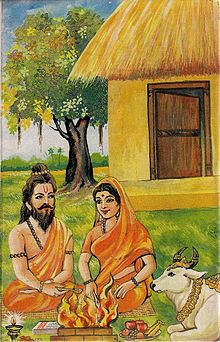Vasishta
| Vashistha | |
|---|---|

Vashistha with his wife Arundhati and Kamadhenu cow
|
|
| Religion | Hinduism |
| Known for | Rigvedic hymns |
| Spouse | Arundhati |
| Children | Śakti Maharṣi |
| Honors | Maharishis |
Vashistha (Sanskrit: वशिष्ठ, वसिष्ठ, IAST: Vaśiṣṭha) is a revered Vedic sage in Hinduism. He is one of the Saptarishis (seven great Rishis) of India. Vashistha is credited as the chief author of Mandala 7 of Rigveda. Vashistha and his family are mentioned in Rigvedic verse 10.167.4, other Rigvedic mandalas and in many Vedic texts. His ideas have been influential and he was called as the first sage of the Vedanta school of Hindu philosophy by Adi Shankara.
Yoga Vasistha, Vashistha Samhita, as well as some versions of the Agni Purana and Vishnu Purana are attributed to him. He is the subject of many mythologies, such as him being in possession of the divine cow Kamadhenu and Nandini her child, who could grant anything to their owners. He is famous in Hindu mythologies for his legendary conflicts with sage Visvamitra.
Vashistha is also spelled as Vasiṣṭha ( Malayalam: വശിഷ്ടൻ) Thai: Vasit, Tamil: வசிட்டர், Telugu: వశిష్ఠ). वसिष्ठ literally means most excellent , best or richest.
In Rigvedic hymn 7.33.9, Vasistha is described as a scholar who moved across the Indus river to establish his school. He was married to Arundhati, and therefore he was also called Arundhati Nath, meaning the husband of Arundhati. Vashistha is believed to have lived on the banks of Ganga in modern-day Uttarakhand. Later, this region is believed in the Indian tradition to be the abode of sage Vyasa along with Pandavas, the five brothers of Mahabharata. He is typically described in ancient and medieval Hindu texts as a sage with long flowing hairs that are neatly tied into a bun that is coiled with a tuft to the right, a beard, a handlebar moustache and a tilak on his forehead.
...
Wikipedia
